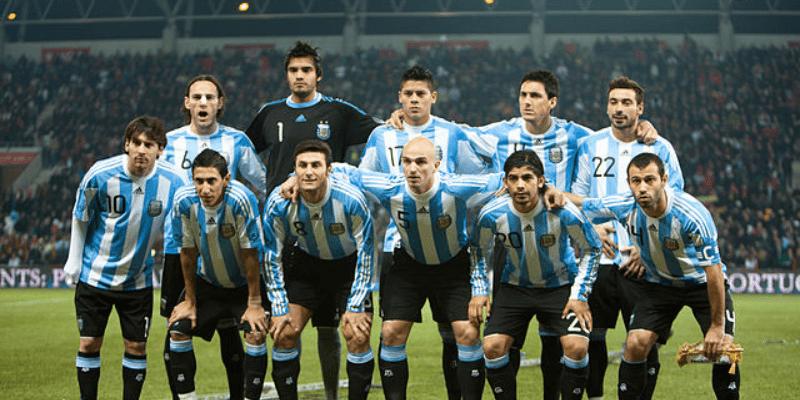From the moment the whistle blows and the sky-blue and white stripes flood the pitch, fans everywhere refer to the Argentine national team as La Albiceleste. But where did this poetic nickname come from, and what does it really mean? In this article, KorKick will guide you through the origin, symbolism, legends, and enduring power behind the name why is argentina’s national team nicknamed la albiceleste — and how it continues to define one of football’s most storied identities.
What Does “La Albiceleste” Mean?

The nickname La Albiceleste fuses two Spanish roots: alba (white, dawn) and celeste (sky blue). Put together, it evokes “the white and sky-blue,” a direct reference to the national colors of Argentina. These colors trace back to the Argentine flag, which features alternating light blue and white horizontal stripes with a golden sun at the center.
Over time, those sky-blue and white stripes weren’t only part of the flag — they were woven into Argentina’s football identity, on kits, emblems, and hearts of fans. Because those two colors are so central to Argentina’s visual presence in the world of football, the nickname La Albiceleste became shorthand for the national squad itself.
Historical Roots of the Nickname
To understand why is argentina’s national team nicknamed la albiceleste, we must look back at early shirt choices and evolving symbolism.
First Kits and Early Adoption
- Argentina’s first matches in the early 1900s featured light blue or alternate colors, but it wasn’t until 1908 that the team debuted the classic sky-blue vertical stripes over a white base. That striped kit was used in an official match against Uruguay in September 1908. This combination solidified a visual identity that stuck.
- As decades passed, the sky-blue & white combination became inseparable.
Why It Stuck
Colors in football often carry symbolic weight. For Argentina:
- National identity: Light blue and white mirror the national flag, making every match something like a projection of national pride.
- Uniqueness and recognition: Among South American teams, Argentina’s kit stands out. The distinct palette helps the nickname stand out in the minds of the public.
- Romantic resonance: “Albiceleste” isn’t utilitarian — it has emotion, poetry. It captures both purity (white) and the heavens (sky blue). It’s more than a nickname, it’s identity.
Thus, La Albiceleste became the poetic, affectionate way to refer to Argentina’s national team.
How the Nickname Reflects Argentina’s Football Identity

Beyond colors, La Albiceleste came to symbolize traits, ambitions, and ethos of the Argentine national project in football.
A Legacy Woven in Stripes
When you see that striped shirt, you see legends — from Guillermo Stábile to Diego Maradona, to Lionel Messi. The nickname links past, present, and future under one banner of identity. The colors become more than aesthetic; they become continuity, memory, aspiration.
Pride, Passion, and Expectation
Wearing the colors of your nation in sport carries inherent expectation. To be La Albiceleste is to carry the hopes of a football-mad nation that breathes the game. The nickname connotes a standard, a legacy of resilience, brilliance, and dramatic moments under pressure.
Branding, Marketing, and Global Recognition
In the modern era, nicknames carry branding power. “La Albiceleste” is distinctive, evocative, and marketable., it reinforces the idea that this is not just a team — it’s a symbol.
Variants, Evolving Nicknames, and Memes
While La Albiceleste remains the classic and canonical moniker, it has evolved and spawned offshoots over time.
La Selección and “La Sele”
Argentina is also known simply as La Selección (The Selection). This is a common tag for national teams in Spanish. It’s more functional, less poetic, but still used — sometimes in media headlines or casual conversation.
La Scaloneta: Modern Flair
In the last several years, another nickname gained steam: La Scaloneta — a playful blend of coach Lionel Scaloni’s name and camioneta (van). It suggests the team as a vehicle led by Scaloni, bringing fans along on a winning journey. The nickname took off especially after Argentina’s 2021 Copa América title ended a decades-long trophy drought. Though distinct, La Scaloneta often appears alongside the undiminished legacy of La Albiceleste.
Records, Legends & Stats Under the Albiceleste Banner

When you ask why is argentina’s national team nicknamed la albiceleste, you also want to hear what that team has achieved under that banner.
World Cups, Copa Américas & More
- Argentina has won three FIFA World Cups (1978, 1986, 2022), with six final appearances.
- In the Copa América, they hold 16 titles, making them the most successful team in the competition.
- Beyond major trophies, Argentina also claimed the 1992 Confederations Cup and multiple CONMEBOL-UEFA Cup of Champions.
These achievements are etched into Albiceleste lore and color.
Icons Who Wore the Colors
Under the stripes, footballing gods have walked:
- Diego Maradona, who single-handedly carried Argentina in 1986.
- Lionel Messi, the all-time leading scorer and most capped player for Argentina.
- Historic figures like Mario Kempes, Gabriel Batistuta, Juan Román Riquelme, and many others who define eras.
Their artistry, heartbreaks, redemption arcs — all tied to the colors of La Albiceleste.
Why the Nickname Still Matters Today
Even in an age of kits changing every few years, global branding, and commercial deals, La Albiceleste remains more than a tag — it remains identity. Here’s why it endures:
- Continuity: Modern kits may evolve, but sky blue and white persist.
- Emotional resonance: Fans still chant “¡Vamos Albiceleste!” with pride and passion.
- Cultural embedding:, it’s everywhere in Argentine football culture.
So when fans search why is argentina’s national team nicknamed la albiceleste, they aren’t just curious — they’re affirming that identity.
Conclusion
In summary, why is argentina’s national team nicknamed la albiceleste? Because their identity is inseparable from the white and sky-blue stripes — colors born, KorKick encourages you to dive deeper: check out match histories, player biographies, and classic Albiceleste moments. And if you ever wonder again why Argentina is called La Albiceleste — now you know.






